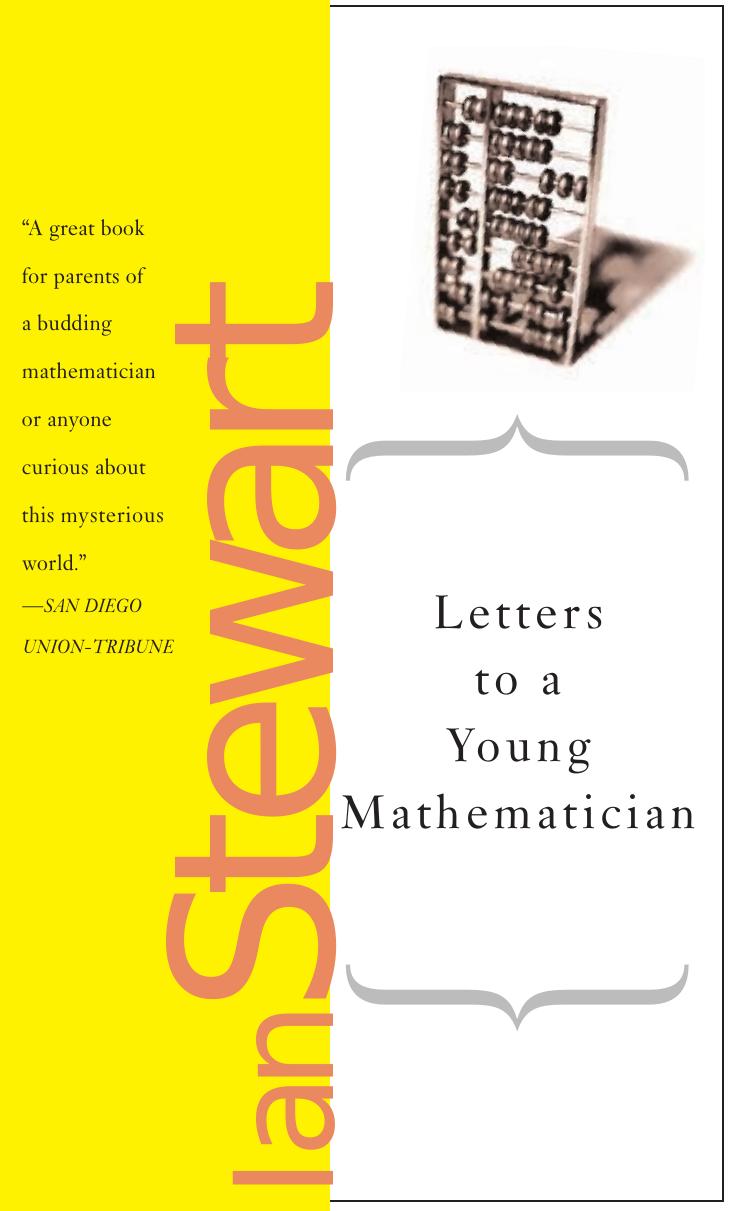Letters to a Young Mathematician by Ian Stewart

Author:Ian Stewart [Stewart, Ian]
Language: eng
Format: epub, mobi, pdf
Tags: Non-Fiction, Philosophy, Science
ISBN: 9780465008414
Publisher: Basic Books
Published: 2006-03-27T00:00:00+00:00
13
Impossible Problems
Dear Meg,
Please don’t try to trisect the angle. I’ll send you some interesting problems to work on if you want to flex your research muscles already; just stay clear of angle trisection. Why? Because you’ll be wasting your time. Methods that go beyond the traditional unmarked ruler and compass are well known; methods that do not cannot possibly be correct. We know that because mathematics enjoys a privilege that is denied to most other walks of life. In mathematics, we can prove that something is impossible.
In most walks of life, “impossible” may mean anything from “I can’t be bothered” to “No one knows how to do it” to “Those in charge will never agree.” The science fiction writer Arthur C. Clarke famously wrote that “When an elderly and distinguished scientist declares something to be possible, he is very likely right. When he declares it to be impossible, he is almost certainly wrong.” (Clarke was writing in 1963, when most scientists, especially elderly and distinguished ones, were almost certainly “he.”) But applied to mathematicians and mathematical theorems, Clarke’s statement is plain wrong. A mathematical proof of impossibility is a virtually unbreakable guarantee.
I say “virtually” because sometimes the impossible can become possible if the question is subtly changed. Then, of course, it’s not the same question. Archimedes knew how to trisect an angle using a marked ruler and compass.
My favorite simple impossible problem is a puzzle. Though it looks frivolous at first glance, it provides a lot of insight into logical inference in mathematics, and in particular into how we know that some tasks are impossible. The puzzle is this: given a chessboard with two diagonally opposite corners missing, can you cover it with thirty-one dominoes, each just the right size to cover two adjacent squares?
It must be understood that no “cheating” is allowed. The dominoes must not overlap, or be cut up, or anything like that.
The first question to ask is reasonably straightforward and comes naturally to any mathematician: is the area an obstacle to success? The total area of the mutilated chessboard is 64 - 2 = 62 squares. The total area of the dominoes is 2 × 31 = 62 squares. So we have exactly the right number of dominoes to cover the chessboard. If we had been given only thirty, then calculating the total area would immediately have proved that the task is impossible. But we’ve been given thirty-one, so the area is not an obstacle.
Meg, I know you’ve done a lot of math, but it’s just possible that you’ve never come across this puzzle. Puzzles do not feature prominently in university textbooks. Please try it. For the moment, don’t think about it; just cut out some cardboard dominoes and try to fit them together.
Done that? Did you get anywhere?
No. You tried and tried but nothing worked. You can see why if you count the black and white squares.
Every domino, no matter where it is placed, covers one black and one white square of the chessboard. So any arrangement of nonoverlapping dominoes must cover the same number of black squares as white.
Download
Letters to a Young Mathematician by Ian Stewart.mobi
Letters to a Young Mathematician by Ian Stewart.pdf
This site does not store any files on its server. We only index and link to content provided by other sites. Please contact the content providers to delete copyright contents if any and email us, we'll remove relevant links or contents immediately.
| Applied | Geometry & Topology |
| History | Infinity |
| Mathematical Analysis | Matrices |
| Number Systems | Popular & Elementary |
| Pure Mathematics | Reference |
| Research | Study & Teaching |
| Transformations | Trigonometry |
Modelling of Convective Heat and Mass Transfer in Rotating Flows by Igor V. Shevchuk(6406)
Weapons of Math Destruction by Cathy O'Neil(6205)
Factfulness: Ten Reasons We're Wrong About the World – and Why Things Are Better Than You Think by Hans Rosling(4710)
A Mind For Numbers: How to Excel at Math and Science (Even If You Flunked Algebra) by Barbara Oakley(3248)
Descartes' Error by Antonio Damasio(3247)
Factfulness_Ten Reasons We're Wrong About the World_and Why Things Are Better Than You Think by Hans Rosling(3216)
TCP IP by Todd Lammle(3153)
Fooled by Randomness: The Hidden Role of Chance in Life and in the Markets by Nassim Nicholas Taleb(3078)
Applied Predictive Modeling by Max Kuhn & Kjell Johnson(3038)
The Tyranny of Metrics by Jerry Z. Muller(3025)
The Book of Numbers by Peter Bentley(2927)
The Great Unknown by Marcus du Sautoy(2661)
Once Upon an Algorithm by Martin Erwig(2619)
Easy Algebra Step-by-Step by Sandra Luna McCune(2603)
Lady Luck by Kristen Ashley(2552)
Police Exams Prep 2018-2019 by Kaplan Test Prep(2513)
Practical Guide To Principal Component Methods in R (Multivariate Analysis Book 2) by Alboukadel Kassambara(2512)
All Things Reconsidered by Bill Thompson III(2369)
Linear Time-Invariant Systems, Behaviors and Modules by Ulrich Oberst & Martin Scheicher & Ingrid Scheicher(2346)
